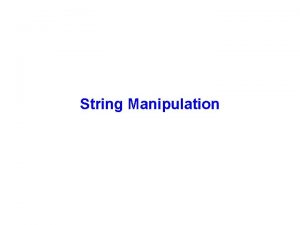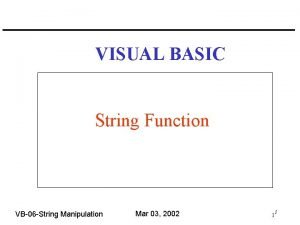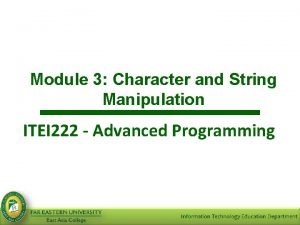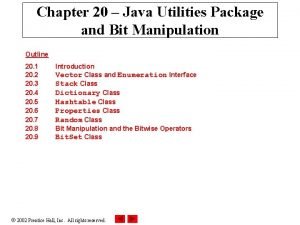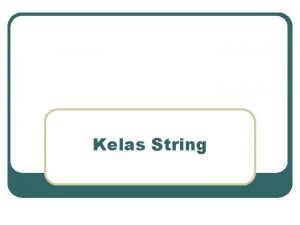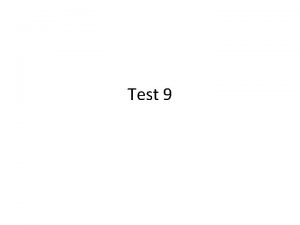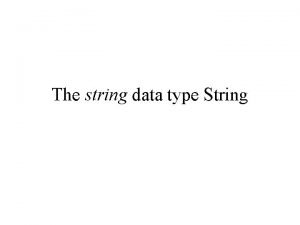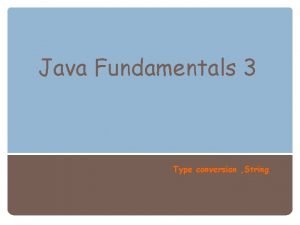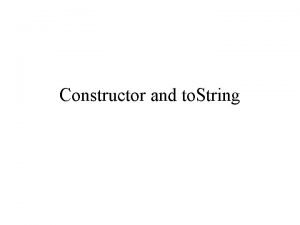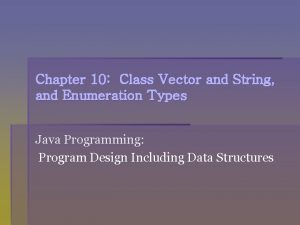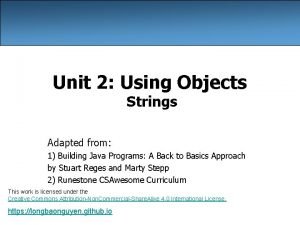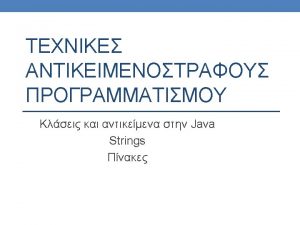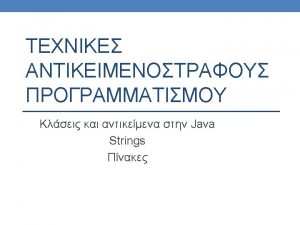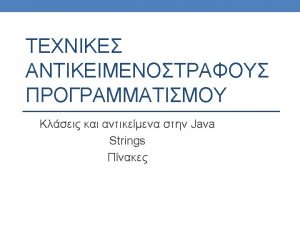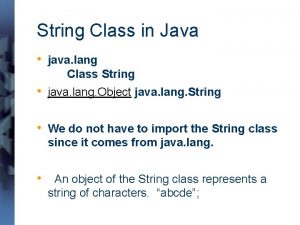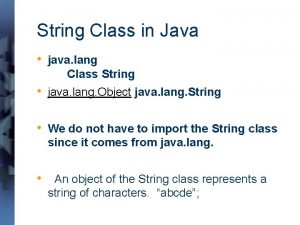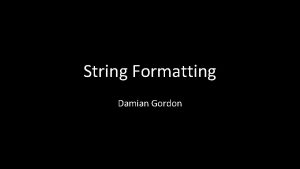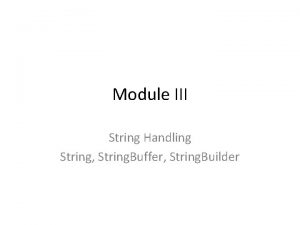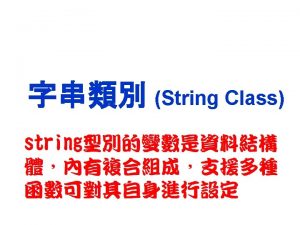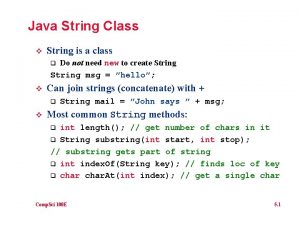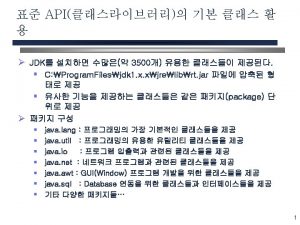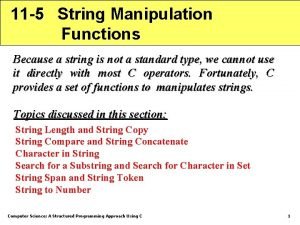String Manipulation Java String class The String class


















- Slides: 18

String Manipulation

Java String class ® The String class represents character strings “Tammy Bailey” All strings (arrays of characters) in Java programs are implemented as instances of this class ® Declaration String name; ® ® Assignment name = “Tammy Bailey”; ® Declare and initialize String name = “Tammy Bailey”;

Concatenation operator ® Strings can be concatenated (“added together”) using the concatenation operator + String first = “Tammy”; last = “Bailey”; name = first + “ ” + last; greeting = “Hello ” + first; The string variable name contains the string “Tammy Bailey” ® The string variable greeting contains the string “Hello Tammy” ®

String indexing and length Characters in strings are indexed the same as arrays – first index is 0 – last index is one less than the number of characters ® The length of a string is the number of characters in the string – letters, numbers, spaces, punctuation, etc. – the length method returns the length of a string ® ® Example String name = “Tammy Bailey”; int len = name. length(); – The value of len is 12

String characters char. At(int index) – returns the character at the specified index ® String replace(char old, char new) – returns new string resulting from replacing all occurrences of the old character with new ® String to. Lower. Case() – returns new string with all characters in lowercase ® Examples String name = “Tammy Bailey”; char c = name. char. At(8); String s 1 = name. replace(‘y’, ‘i’); String s 2 = name. to. Lower. Case(); ®

String indices int index. Of(String s) – returns the index of the first occurrence of the specified substring ® int index. Of(String s, int index) – returns the index of the first occurrence of the specified substring, starting at the specified index ® Examples String name = “Tammy Bailey”; idx 1=4 int idx 1 = name. index. Of(“y”); idx 2=2 int idx 2 = name. index. Of(“mm”); idx 3=-1 int idx 3 = name. index. Of(“Z”); idx 4=11 int idx 4 = name. index. Of(“y”, 5); ®

Substrings ® String substring(int start. Idx) – returns a new string that is a substring of the string – the substring begins with the character at start. Idx and extends to the end of the string ® String substring(int start. Idx, int end. Idx) – returns a new string that is a substring of the string – the substring begins at start. Idx and extends to the character at index end. Idx-1 – the length of the substring is end. Idx-start. Idx

Substring examples String name = “Tammy Bailey”; String sub 1 = name. substring(8); String sub 2 = name. substring(0, 3); String sub 3 = name. substring(name. index. Of(‘B’)); String sub 4 = name. substring(0, name. index. Of(“ ”)); • • sub 1 sub 2 sub 3 sub 4 = = “iley” “Tam” “Bailey” “Tammy”

Strings and loops ® What does the string name contain after exiting the while-loop? String name = “Tammy Lynn Bailey”; int index = 0; while(index != -1) { name = name. substring(index); index = name. index. Of(“ ”); }

Another example ® What is the value of count after exiting the while-loop? String s = “How many words are there? ”; int count = 0; int index = 0; while(index != -1) { count++; index = s. index. Of(“ ”, index+1); }

Parsing strings ® String email = “tammy@cs. duke. edu”; String login = email. substring(0, email. index. Of(“@”)); String host = email. substring(email. index. Of(“@”)+1); ® String name = “Bailey, Tammy”; String first = name. substring(name. index. Of(“, ”)+1); String last = name. substring(0, name. index. Of(“, ”));

Pig Latin If a word begins with a consonant, move all of the characters up to the first vowel to the end of the word and add “ay” – bad becomes adbay ® If a word begins with a vowel, write the word and add “way” – add becomes addway ® Y is not a vowel. – yes becomes esyay ® If there are no vowels in the word, just write the word – why becomes why ®

Pig Latin Converter How to design a program to convert words to Pig Latin? ® Need to find first occurrence of a vowel – word begins with vowel, or – word begins with consonant and we move all letters up to first vowel, or – there are no vowels in the word ® Idea: loop through characters in word until vowel is found or we go through all characters (no vowels) ® String methods to use – length, index. Of, char. At ®

Subroutine Find. First. Vowel int Find. First. Vowel(String word) returns index of first vowel found in word { or – 1 if word contains char c; no vowels int index = -1; word = word. to. Lower. Case(); while(index < word. length()) { c = word. char. At(index); if(c==‘a’||c==‘e’||c==‘i’||c==‘o’||c==‘u’) return index; index++; } return – 1; }

Conversion cases Use the integer returned by Find. First. Vowel to determine how to convert the word to Pig Latin ® Three cases – Find. First. Vowel returns 0 ® • word begins with vowel – Find. First. Vowel returns – 1 • no vowels in world – Find. First. Vowel returns positive integer • word begins with a consonant • know index of first occurrence of vowel

Subroutine Convert String Convert(String s) { int i = Find. First. Vowel(s); if( i == 0 ) { /* word begins with vowel */ } else if( i > 0 ) { /* word begins with consonant but has a vowel */ } else { /* word has no vowels */ } }

Text Areas ® ® ® A Text. Area is similar to a Text. Field – Differences: has both rows and columns, has scrollbars, can append text Declare a Text. Area object Text. Area; Initialize t. Area with 5 rows and 60 columns t. Area = new Text. Area(5, 60); Set text in Text. Area. set. Text(“Hello”); Append text to existing text in t. Area. append(“ there”); – t. Area now contains the text “Hello there”

Newline character The newline character ‘n’ terminates a line of text – any text following the newline character begins on the next line – used in display/formatting of output text ® Example – a Text. Area object displays multiple lines of text – can append the newline character to the end of the output string – subsequent output will display on a new line t. Area. set. Text(“Hello. ”); t. Area. append(“n”); t. Area. append(“How are you? ”); ®
 Picture to word converter
Picture to word converter Http protocol description
Http protocol description New string
New string Public class person string name
Public class person string name Vb string manipulation
Vb string manipulation String manipulation
String manipulation C string manipulation
C string manipulation Python
Python Bit manipulation java
Bit manipulation java Class maths student student1 class student string name
Class maths student student1 class student string name Const char *s =
Const char *s = Java string operation
Java string operation Private string java
Private string java String data type in java
String data type in java Java string methods
Java string methods String conversion
String conversion Java string methods
Java string methods Modifying string in java
Modifying string in java Strings in java
Strings in java
